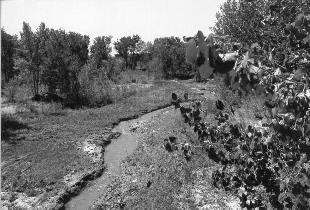Over the Hills
Just past the mouth of Jimmy Camp Creek, in present downtown Fountain, the old trail split into two branches. One branch - known as the Ute Trail - continued northeast along the bank of Fountain Creek to the springs of Manitou, then around the shady side of Pikes Peak in the direction of South Park. The other branch - which in later years would come to be called the Jimmy Camp Road - left Fountain Creek to head due north over the hills toward Jimmy Camp and the Black Forest beyond.
 Jimmy Camp Creek near its Mouth
Jimmy Camp Creek near its Mouth
Luke Tierney, 19 July 1858.
Luke Tierney and the Russell Party got a late start on the climb from Fountain Creek. Almost a dozen miles of waterless, rolling hills lay between them and night camp at the head of Jimmy Camp Creek.
BR>
“After leaving the creek, we traversed about twelve miles of beautiful plains, high and rolling, covered with excellent grass .... We were obliged to march until ten o'clock that night in order to reach a spring - the only spring we drank of in traveling a distance of over five hundred miles. There we camped for the night.”
Source: "Luke Tierney Guidebook," Pike's Peak Gold Rush Guidebooks of 1859, ed. by LeRoy R. Hafen. (Glendale, Calif.: The Arthur H. Clark Co., 1941).
David Kellogg, 28 October 1858.
While passing the ruins of the old Pueblo on the afternoon of 24 October the Kellogg Party had found living nearby one George McDougal, together with his Mexican woman and several of her companions. McDougal had advised the gold seekers that they would find plenty of antelope further up the trail near Jimmy Camp. His prediction came true in the hills just to the south of the famed campground.
“We camped last night at the foot of the divide at the bend of the creek [Fountain Creek] to get shelter from the cold north wind. Broke camp early and drove up onto the high land, going north toward the pine-covered hills. It seems but an hour's walk to the Peak although it is twenty miles away. The trail here follows the divide between two valleys. About nine o'clock those of us at the train heard so much firing in the valley to the right that we thought it an attack by Indians. Hurriedly doubling teams we were preparing to go to the help of our friends when a heavy firing in the valley to our left made Topeka and myself decide to go there.
“Arriving at the edge of the plateau, we saw a party of our men surrounded by an immense herd of antelope into which they were firing like mad people; the antelope were circling around and around them, completely bewildered, having entirely lost their good animal sense. Several offshoots from the main herd came in our direction; one column ran up the slope close to us, another passed at the foot. I fired and loaded as fast and as wild as a man with the Buck ague could do and was awarded by one antelope. Large numbers ran around and under the wagons and among the oxen with the train; the drivers caught several bucks by the horns but could not hold them.”
Source: "Across the Plains in 1858," The Trail, Vol.V, No.& (December, 1912).
A.E.Raymond, 30 May 1859.
Gold Seeker from Kansas City.
“Mon May 30th Started from Camp early in the morning and made a good days drive of 21 mls. Over a rolling country and quite sandy - the day was warm the afternoon windy - drove all day - stood guard at night. Saw six antelopes in the afternoon.”
Source: "Samuel D. Raymond Journal," edited by Lloyd W. Gundy. Wagon Tracks, Vol.10, No.1 (November, 1995).
Dr. George M. Willing, 8 June 1859.
Gold Seeker from St. Louis.
“At 12 M., leave the Fountain river, the water of which, fresh from the moutain snow, was delightfully cool and refreshing, and strike across the hill for the head of Cherry Creek.”
Source: "Diary of a Journey to the Pike's Peak Gold Mines in 1859," ed. by Ralph P. Bieber. The Mississippi Valley Historical Review, Vol.XIV (June 1927-March 1938).
Next Page
Home Page
©2000 Richard Gehling
E-mail me.

